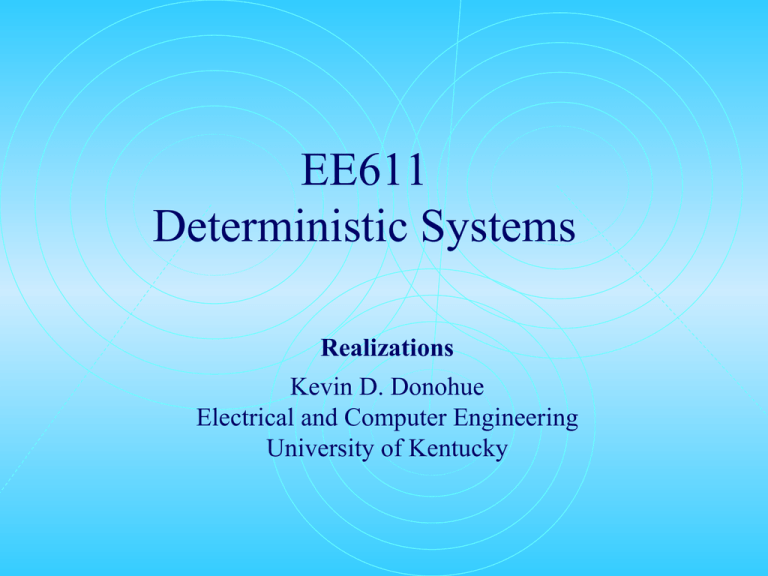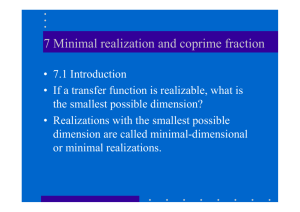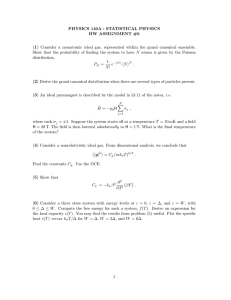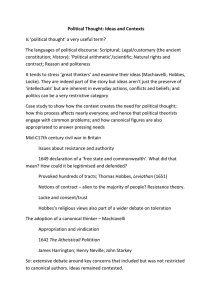EE611 Deterministic Systems Realizations Kevin D. Donohue
advertisement

EE611
Deterministic Systems
Realizations
Kevin D. Donohue
Electrical and Computer Engineering
University of Kentucky
Minimal Realizations
Realizations are not unique, they may have different
bases and different orders while still realizing the same
transfer matrix. A minimal realization is one with the
smallest possible dimension.
An important condition for transfer functions if that of
being coprime.
g s=
y s N s
=
u s D s
For a SISO TF
N(s) and D(s) are
coprime iff they have no common factors.
Controllable Canonical Form
Consider SISO system with strictly proper TF:
3
2
1 s 2 s 3 s4
y s
N s
g s=
= 4
=
u s s 1 s3 2 s 2 3 s 4 D s
this corresponds to:
4
3
2
3
2
d y
d y
d y
dy
d u
d u
du
y=
4 u
1
2
3
4
1
2
3
4
3
2
3
2
dt
dt
dt
dt
dt
dt
dt
State variables can defined as derivatives of y such that
derivatives of the input are accounted for. Define
auxiliary variable v such that:
−1
y s= N s D s u s= N s v s
where:
−1
D s u s= v s
u s= D s v s
State Variable Definition
Define state variables from v as:
and ẋ 1 is determined from
u s= D s v s
ẋ 1=u−1 x1 −2 x 2−3 x3 −4 x 4
and y is obtained from
x 4=v
x 3 = ẋ 4 =v̇
x 2= ẋ 3 =v̈
x 1 = ẋ 2 =v
y s= N s v s
y=1 x 12 x 2 3 x3 4 x 4
Controllable Canonical Form
Can be realized with
[][
ẋ 1
−1 − 2 −3 −4
ẋ 2
0
0
0
= 1
ẋ 3
0
1
0
0
0
0
1
0
ẋ 4
y t =[ 1 2 3 4 ]
][ ] [ ]
x1
1
x2
0
ut
0
x3
0
x4
[]
x1
x2
x3
x4
Controllable Canonical Form
Can be realized with β
1
β2
β3
u(t)
+
ẋ1
1
s
−α1
1
ẋ 2 s
1
ẋ 3 s
1
ẋ 4 s
−α2
β4
+
y(t)
−α3
−α4
Minimal Realizations
y s N s
=
Given a SISO TF g s=
:
u s D s
The controllable canonical form is observable iff N(s)
and D(s) are coprime.
State equation {A, b, c, d} is a minimal realization of
proper rational TF g s iff {A, b} is controllable and
{A, c} is observable or iff dim [A] = deg[g s].
All minimal realization of g s are equivalent.
Controllable Canonical Form
Consider SISO system with strictly proper TF:
3
2
1 z 2 z 3 z4
y z
N z
g z=
= 4
=
u z z 1 z 3 2 z 2 3 z 4 D z
this corresponds to:
y [n4 ] 1 y [n3 ] 2 y [n2] 3 y [n1] 4 y [n]
=1 u [n3]2 u [n2]3 u [n1 ]4 u [n ]
Can define state variables as time delays on y such that
time delays of the input are accounted for. Define
auxiliary variable v[n] such that:
−1
y z = N z D z u z = N z v z
where:
−1
D z u z= v z
u z= D z v z
State Variable Definition
x 4 [n]=v [n ]
x 3 [n ]= x 4 [n1]=v [n1]
x 2 [n ]= x 3 [n1]=v [n2]
x 1 [n ]= x 2 [n1 ]=v [n3]
Define state variables from v as:
and x 1 [n1] is determined from
u z= D z v z
x 1 [n1]=u[n]−1 x 1 [n]−2 x2 [n]−3 x3 [n]− 4 x 4 [n]
and y is obtained from
y z= N z v z
y [n]=1 x1 [n]2 x 2 [n]3 x3 [n]4 x 4 [n]
Controllable Canonical Form
Can be realized with
[ ][
x 1 [n1]
−1 −2 −3 − 4
x 2 [n1]
0
0
0
= 1
x 3 [n1]
0
1
0
0
0
0
1
0
x 4 [n1]
y [n]=[ 1 2 3 4 ]
][ ] [ ]
[]
x1 [n]
x 2 [n]
x3 [n]
x 4 [n]
x1 [n]
1
x 2 [n]
0
u[n]
0
x3 [n]
0
x 4 [n]
Controllable Canonical Form
Can be realized with β
1
β2
β3
u[n]
x1 [n1]
+
x 2 [n1]
-1
x 4 [n1]
-1
-1
Z
−α1
x 3 [n1]
-1
Z
Z
Z
−α2
β4
+
y[n]
−α3
−α4
Observable Canonical Form
Given an observable system
ẋ=A xb ut
y t =c x
with characteristic polynomial
s=∣s I−A∣=sn1 s n−1 2 sn−2... n−1 s n
system can be transformed into observable canonical
form by x =P x
[
n−1 n−2
n−2 n−3
−1
P=Q = ⋮
⋮
1
1
1
0
...
...
⋰
...
...
1
1
⋮
0
0
][ ]
c
1
cA
0
c A2
⋮
c A3
0
⋮
0
n−1
cA
Observable Canonical Form
[ ][
0 0 ...
̇x 1
1 0 ...
̇x 2
⋮ =⋮ ⋮ ⋱
0 0 ...
̇x n−1
0 0 ...
̇x n
][ ] [ ]
[]
0 − n
n
x 1
0 − n−1 x 2
n−1
⋮
⋮
⋮ ⋮ ut
0 − 2 x n−1
2
1 − 1
1
x n
x 1
x 2
y t = [ 0 0 ... 0 1 ] ⋮
x n−1
x n
n−1
n−2
1 s 2 s ⋯n−1 sn
y s
g s=
=
u
s sn 1 sn−1 2 sn−2 ⋯ n−1 s n
Computing Coprime Fractions
Consider equivalent proper rational polynomials:
N s N s
g s=
=
D s Ds
N(s) and D(s) are not coprime iff ∃ a D s ∋
deg [ D s] < deg[D(s)].
Let the coefficients of D s and N s be unknowns and
their polynomial degrees one less than deg[D(s)]. The
above equation can be multiplied out and like terms
equated to form a set of linear equations (equal to zero).
The coefficient matrix in terms of coefficients N(s) and
D(s) with unknowns coefficients of D s and N s , form
the Sylvester resultant.
Coprime and Sylvesters Resultant
Consider equivalent proper rational polynomials:
N s N s
g s=
=
D s Ds
N(s) and D(s) are coprime iff Sylvesters resultant is
nonsingular.
s
D
N s
Lecture Note Homework U10.1
Implement the system below in Simulink using delays, summers,
and gains.
[
]
[]
0.5 −0.25
1
x [k 1]=
x[ k ] u[ k ]
0
0.1
2
y [ k ]= [ 1 0 ] x [k ]
Assume the system is relaxed at k = 0.
A) Plot the output when the input is the unit impulse.
B) Plot the output when the input is the unit step.
Lecture Note Homework U10.2
Find a minimal realization of the system below. Implement the
system below in Simulink using integrators, summers, and gains.
2
y s
N s
s 3s2
g s=
= 6
=
u
s s 7.5 s5 31.5 s4 84 s3123 s 284 s20 D s
Assume the system is relaxed at t = 0.
A) Plot the output when the input is the unit impulse.
B) Plot the output when the input is the unit step.







